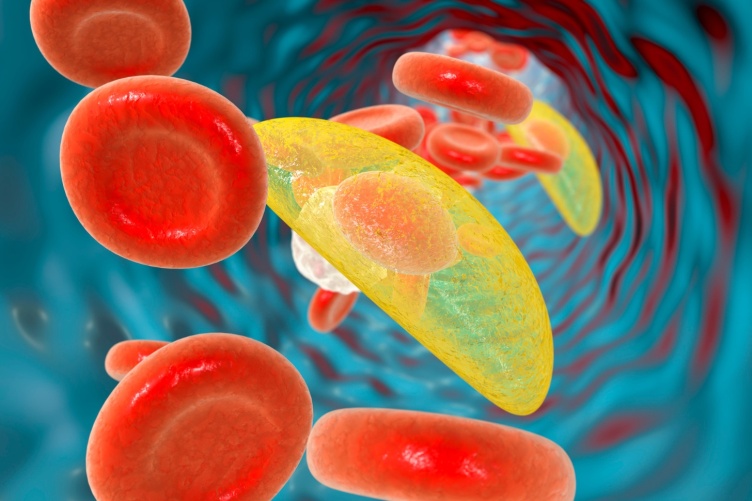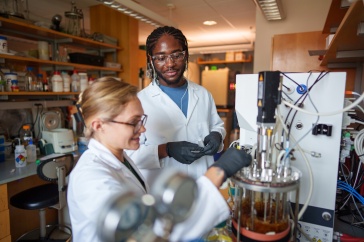
An illustration of toxoplasma gondii cells (in yellow) entering the blood stream.
Key Finding
The protein bromodomain protein 1 (or BDP1) plays a key role gene regulation to allow the parasite Toxoplasma gondii to infect and cause disease in its host.
Key Terms
Bromodomain protein 1 (or BDP1): A protein in Toxoplasma and related parasites that contains a bromodomain which gives it the ability to "read" marks on the genome and control gene expression.
Cryptosporidium (or Crypto): A parasite that causes the diarrheal disease cryptosporidiosis, which can infect both humans and animals.
Eimeria: A genus of parasitic protozoans responsible for the infection coccidiosis in livestock, including cows and chickens, and wild animals.
Toxoplasma gondii (or Toxo): A protozoan parasite that infects most humans and most species of warm-blooded animals.
Toxoplasmosis: The infection caused by toxoplasma gondii. According to the CDC, toxoplasmosis is considered a leading cause of death from foodborne illness in the United States.
Most people haven’t heard of Toxoplasma gondii (or “Toxo” for short), but nearly one out of four Americans likely carries this single-celled parasite, as do pets—especially cats—and domesticated agricultural animals. While Toxo normally remains in a dormant but incurable state, immunocompromised individuals and infants born to infected mothers are at highest risk of developing toxoplasmosis, leading to symptoms ranging from extended periods of flu-like discomfort to more severe cases that can cause damage to the brain, eyes, and other organs. Vicki Jeffers, assistant professor in the UNH College of Life Sciences and Agriculture, continues her decade-long research quest to identify what makes Toxo tick.
Targeting Bromodomain Protein 1
Jeffers’ recent research, which she co-authored and was published in the journal mBio, examines the role a particular part of the parasite—a protein called bromodomain protein 1 (or BDP1)—plays in switching on and off the genes responsible for regulating Toxo infections.
“For Toxoplasma gondii, BDP1 was previously unstudied, so we had no idea what its role would be when we set out,” described Jeffers. “However, we learned that the parasite needs this protein to survive and infect other cells and that it’s a key part of this group of proteins found in the nucleus, sitting right on the area in the genome responsible for switching on a gene.”
Because of this protein’s important role in regulating gene expression, and its unique structure, it could be a good target for treatment via drug therapy. This is important due to the chronic nature of the Toxo infection, which affects both humans and animals by ingesting Toxo via food or water contaminated with parasite-infected cat feces or undercooked or uncooked meat, as well as congenital transmission from an infected mother to unborn child, Jeffers said. And while drug treatments are available for people suffering from active infections, Jeffers added that these drugs have side-effects and may trigger allergies in some.
Addressing Toxo-related Parasites
Jeffers’ findings and continued research is also important because its results could have important implications and treatment breakthroughs for managing other parasitic infections both in humans and agricultural animals.

Two fluorescently stained Toxoplasma gondii tachyzoites—a growth stage of parasites—outlined in red infecting a human cell.
“BDP1 can be found in a lot of parasites related to Toxo, including malaria, the Eimeria parasites that cause coccidiosis in a lot of farm animals and Cryptosporidium which can infect humans,” she added. “So uncovering its role in Toxo could possibly open the doors to treatments of other diseases.”
Jeffers and her research team will next study some of the many roles of BDP1, which they believe to be a multifunctional protein that serves different purposes depending on which other proteins it associates with in the nucleus. Additionally, they’ll look at which molecules could inhibit the functions of BDP1 and further examine how Toxo switches its genes on and off.
This material is based on work supported by the Center of Integrated Biomedical and Bioengineering Research (CIBBR) at UNH through a grant from National Institute of General Medical Sciences (P20GM113131) at the National Institutes of Health.
This work is co-authored by Krista Fleck, Seth McNutt, Feixia Chu and Victoria Jeffers.



















































